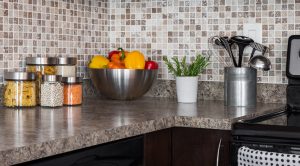
I wondered how to be helpful while we’re sheltering in place due to Coronavirus.
With only life-threatening businesses open in many areas, many of us aren’t working – which means no income. Grocery stores are out of some foods and restricting quantities of popular items. A client continued where we left off decluttering her desk. An acquaintance felt overwhelmed by her cluttered house.
What do these seemingly unrelated things mean? (1) Money is tight. (2) We need to create meals based on what we can get. (3) Spare time. (4) How to be productive while stuck at home. (5) People like order but don’t know how to organize.
Aha! I remembered a post I wrote years ago (7.18.13) with tips to organize your kitchen – specifically food. It was in response to a question from one of my favorite clients, Karen Gibson. Sadly, last December she was diagnosed with stage 4 pancreatic cancer and passed away in January. I’m reposting it (with minor changes) in her honor.
Karen’s question: It occurred to me that we can have food clutter like any other clutter. How do we manage food in the pantry, fridge and freezer and stay on top of expiration dates?
Great question! Food is expensive so we certainly don’t want to waste any. When I work with clients to organize their kitchens, often we end up tossing A LOT of expired food, sometimes hundreds of dollars’ worth.
17 ideas to organize food in your kitchen and eliminate waste
- Empty all food from your pantry and cabinets. Adapt for fridge and freezer.
2. Toss everything that has expired.
3. Sort into categories: canned goods, snacks, spices, baking–whatever makes sense to you.
4. Within categories, group similar items (soup).
5. Assign everything a home and place items near where they’re used, if possible (spices in cooking zone).
6. Put often used items on easy-to-reach shelves and less frequently used items on high or low shelves.
7. Put mom- or dad-approved snacks at child-friendly height.
8. Put taller items behind shorter ones so they are all visible.
9. Put new items behind existing ones and use the ones in front first.
10. Use small containers to corral packets.
11. Use containers to hold categories of food. Baking pans can hold baking supplies. When ready to bake, just grab the pan.
12. Use tiered organizers so everything is visible.
13. Use Lazy Susans and give them a spin to see everything.
14. Once every couple of months or once a quarter do a food inventory. Look in your pantry, cabinets, fridge and freezer and check expiration dates. Use anything nearing expiration. Add what you need to replace to your shopping list.
15. Put newly purchased fresh and frozen food toward the rear and move older food forward.
16. When freezing fresh meat, rewrap in freezer paper, tape shut and label with contents and date.
17. When you run low on something, immediately add it to your shopping list.
Here’s another post I wrote on decluttering the kitchen to get healthy: Is Your Kitchen Making You Fat?
Organizing food in your kitchen makes life at home so much easier – you know what you have and where to find it. It’s not about making your kitchen look like a magazine cover. It’s about form and function – and making super productive use of unexpected spare time!
While I’m unable to work onsite with clients while shelter-in-place is in effect, I can work virtually with you by Zoom, Facetime or phone. Please call or text me if I can help you.
info@organizedapproach.com, 215.540.9401, AnOrganizedApproach.com.

